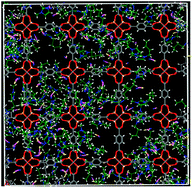Metal–organic framework supported ionic liquid membranes for CO2 capture: anion effects†
Abstract
IRMOF-1 supported ionic liquid (IL) membranes are investigated for CO2 capture by atomistic simulation. The ILs consist of identical cation 1-n-butyl-3-methylimidazolium [BMIM]+, but four different anions, namely hexafluorophosphate [PF6]−, tetrafluoroborate [BF4]−, bis(trifluoromethylsulfonyl)imide [Tf2N]−, and thiocyanate [SCN]−. As compared with the cation, the anion has a stronger interaction with IRMOF-1 and a more ordered structure in IRMOF-1. The small anions [PF6]−, [BF4]−, and [SCN]− prefer to locate near to the metal-cluster, particularly the quasi-spherical [PF6]− and [BF4]−. In contrast, the bulky and chain-like [BMIM]+ and [Tf2N]− reside near the phenyl ring. Among the four anions, [Tf2N]− has the weakest interaction with IRMOF-1 and thus the strongest interaction with [BMIM]+. With increasing the weight ratio of IL to IRMOF-1 (WIL/IRMOF-1), the selectivity of CO2/N2 at infinite dilution is enhanced. At a given WIL/IRMOF-1, the selectivity increases as [Tf2N]− < [PF6]− < [BF4]− < [SCN]−. This hierarchy is predicted by the COSMO-RS method, and largely follows the order of binding energy between CO2 and anion estimated by ab initio calculation. In the [BMIM][SCN]/IRMOF-1 membrane with WIL/IRMOF-1 = 1, [SCN]− is identified to be the most favorable site for CO2 adsorption. [BMIM][SCN]/IRMOF-1 outperforms polymer membranes and polymer-supported ILs in CO2 permeability, and its performance surpasses Robeson's upper bound. This simulation study reveals that the anion has strong effects on the microscopic properties of ILs and suggests that MOF-supported ILs are potentially intriguing for CO2 capture.


 Please wait while we load your content...
Please wait while we load your content...